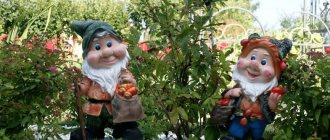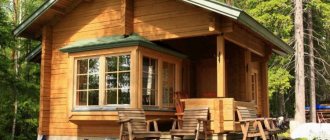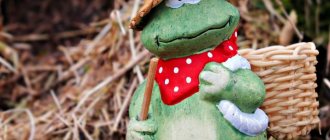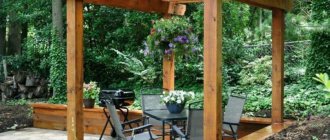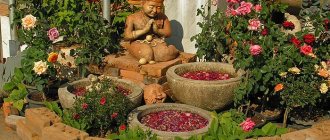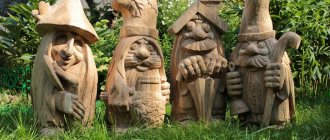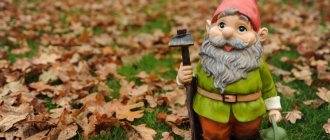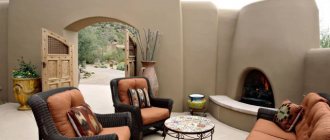Features of using garden figures
The installation of gnomes, nymphs and foresters is popular today not only from an aesthetic point of view, but also from a mythological one. There is a belief that the gnome protects the farmstead and garden from evil spirits, positively influencing the plants, and also brings happiness, a rich harvest and good luck to the owner. In summer it scares away birds wanting to eat fruit from the trees, and in winter it stands out in contrast against the general background.
Before buying or making a gnome with your own hands for the garden, you need to choose the right place for its location and study certain recommendations:
- The first thing to do is draw a dwarf and make a sketch. Then imagine it in the place where it will be. Think about how the figure will look at different times of the year, under different weather conditions: rain, strong wind. If you plan to make several gnomes, they should look harmonious.
- It is important to choose a background landscape and think through the combination with the plants located in the garden. If the gnome is installed in early spring or late autumn, there are no leaves on the trees yet. Therefore, it is necessary to take into account that in summer it may not be visible due to the blooming greenery.
- The place where the garden figurine is installed must be open on all sides. An excellent option is a flower bed, decorative fence, area near a bench or front garden.
- The style of the gnomes should be in harmony with the overall design of the garden. The classic style assumes a standard option, which can be monochromatic or in several color shades. For a romantic garden, it is better to make a composition of several gnomes, made in lilac or soft pink colors. If the design of the garden area is made in country style, wooden gnomes would be the best option. For the Art Nouveau style, a fairy-tale dwarf is made of clay, marble, metal or concrete.
- It is important to remember that even the most exquisite composition can be spoiled by improperly placed garden figures on the site.
- The territory of a personal plot is of considerable importance. For a small garden you cannot choose large figures. They will clutter up the space, which is already not enough. At the same time, in a large garden, small decorations will simply be lost from sight.
Varieties of fairy dwarfs
Gnomes are magical dwarfs from Scandinavian or Germanic folklore. According to legend, they live underground, have beards and are famous for their skill and wealth. In addition, they can cast magic and have supernatural powers. Gnome figurines for the garden can be made of various materials:
- Made from natural wood . Wooden gnomes fit very harmoniously into the overall design of the area. They create comfort, bring joy and warmth. For their manufacture, raw material from branches, logs and driftwood is used. A hat made of moss or leaves would be a great addition.
- Made from natural stone . To make such a gnome yourself, you will need some experience, a hacksaw and a chisel. But the result will be excellent. These figurines are distinguished by their sophisticated appearance and originality and look great in a classic garden. To complement the overall picture, pebbles brought from the lake are used, which can be painted for variety.
- Made from polystone . This material is rarely used, but products made from it are distinguished by their attractive appearance and realism. Polystone is based on acrylic resins, aluminum hydroxide and additional pigments. Gnomes made from it are resistant to temperature changes and durable. The only drawback is the very high cost.
- Made from plaster . These figures are always popular due to their low cost and ease of manufacture. The disadvantages of the material include fragility. To make these gnome plaster, you must have experience in the field of sculpting.
- Made from concrete . Garden gnomes made of cement mortar are durable. To perform them, you will need special forms into which the prepared mixture is poured and waited for it to dry. You can make a figurine of cement in another way - cover the finished frame with mortar. For this you will need ordinary wire. To achieve plasticity and a high level of adhesion of the solution to the frame, it is recommended to add PVA glue or a plasticizer to the mixture.
- Based on straw or hay . You can build a beautiful figurine for the garden using ordinary hay, which is tightly rolled into separate parts.
- From improvised means . Even unnecessary garbage (old basins, flower pots, tires and plastic bottles) can be used as material for making garden figures. A funny figure can be created if you draw the body of a gnome on a large barrel and add a car tire on top in the form of a head.
- Made from polyurethane foam . Garden gnome made of polyurethane foam is resistant to ultraviolet radiation and precipitation. To create a figurine, you will need to prepare a form in the form of a skeleton from plastic bottles, buckets, plates, wire, etc. Excess foam is removed with a stationery knife, the finished product is painted with paints and varnished.
Making a Styrofoam Duck in 10 Steps
It is quite easy to make garden figurines from polystyrene foam. It is convenient to work with this material using available tools, and it is moisture resistant. Let's look at how to make a simple duck from it.
Mark with a marker on the foam the outlines of the head, neck, body, wings and legs of the future duck.
- Cut out the blanks. Do this with a quality utility knife, but slowly and carefully so that the foam does not break.
- Glue the body parts together in at least five places. Use mounting foam or liquid nails as glue.
- Use a knife to remove any excess material that comes out.
- Cover it with polystyrene foam and glue a small tube or beam to the body - this is the future neck.
- Attach the head to it.
- Glue the legs and wings to the resulting figure.
- Cover the duck with putty and leave to dry.
- Sand the resulting sculpture.
- Color the duck.
Other animals are also created from polystyrene foam. Duck is one of the simplest options.
Papier-mâché garden figures
Before you make a gnome with your own hands for the garden, it is important to decide on the material. To make a papier-mâché figurine, you will need to stock up on large quantities of paper egg trays. The trays must be torn into small pieces, placed in a plastic bucket and poured with boiling water so that the paper is completely covered with water. Leave to swell for a day.
Drain off excess water and grind the resulting mass by hand using a fork or mixer. After kneading a homogeneous “dough”, add PVA glue in a small amount to form a plastic mass. If the papier-mâché turns out to be liquid, it should be placed in gauze and hung to drain.
Then make a frame for the gnome figurine from a plastic bottle. Add a little volume at the neck by securing it with cellophane tape. Make a cut with a leg knife. Fill the cut parts of the bottle with paper and secure with tape.
The entire workpiece is wrapped in newspapers to add volume. Clothes and caps are also made from it. The frame of the beard and nose is made from wire.
At the last stage, carefully coat the frame on all sides with papier-mâché, giving the figurine the desired shape.
After making the gnome with your own hands, it is painted and varnished.
DIY plaster gnome
Another easy option for making a garden gnome is to sculpt a figure from plaster. This material is resistant to cold, precipitation and ultraviolet radiation. But the gypsum gnome does not withstand mechanical stress, so it must be installed in a place protected from the wind. To work you will need:
- sculpture plaster;
- PVA construction adhesive;
- acrylic paints and brushes;
- varnish;
- stationery knife;
- pencil;
- sunflower oil;
- forms for working with plaster.
Gypsum is diluted with water according to the instructions. The specified proportions must be observed. For work, use a plastic or rubber tank. After mixing the solution well, add PVA glue to increase elasticity and ductility. The amount of glue should be one process of the total mass.
For a gnome less than 50 cm in size, preliminary construction of a skeleton is not required. Gypsum is poured into a shaped mold, for example a silicone one, which can be purchased at any hardware store.
To build a large sculpture, you will need to make a metal frame from reinforcing bars. To fix the product on the ground, a protruding element is built at the bottom of the gnome.
What will you need?
Mom, knowing how to work with cement, prepared the following building materials in advance.
- Cement.
- Sand.
- Water.
- Plastic spatulas of various sizes.
- A pair of nylon stockings.
- Two medium-sized plastic bowls.
- Knitting.
- Scissors.
- The simplest hair ties (set of 10 pcs.)
- Accessories (we will discuss this item in more detail later).
That's all. These things can either be found at home or bought for pennies in the nearest stores. Having prepared all this, you can get to work.
Fancy costume for a gnome
Dwarves are a wealthy and colorful people, so the figures should look accordingly. The costume of this fabulous exhibit consists of several elements: shirt, pants, vest, cap and knee socks.
It is better to make the shirt plain with wide sleeves and belt it with a rope at waist level, which will add additional volume. A bright vest, for example blue or red, is worn on top of the shirt. You can sew it yourself by downloading a pattern on the Internet.
Next - red pants above the knee. To do this, you can cut off old trousers or buy breeches. Bows or bells are sewn along the seam line on the side. Under the breeches, wear stockings, tights or leggings with horizontal wide stripes.
Any shoes will do for a gnome.
One of the most important elements is the cap, which can be made from a Santa Claus hat, starched it, or made from cardboard. Decorate the headdress with a bow with a bell or bell.
To complete the look, you should use a beard made of cotton wool, or taken from Santa Claus. The longer the beard, the richer the gnome. And finally, give him a paper lantern and a red bag on a long stick.
Tags
with your own hands with your own hands their with your own hands with your own hands for with your own hands for with your own hands with wide sleeves and with sleeves and with your own hands with your own hands the plot make unusual them make easy gnomes with your own hands gnomes. With your own hands, a gnome with your own hands, a gnome with your own hands, a gnome with your own hands, have lost their popularity. Delighting with your bright clothes, a hammock with your own hands
articleanswerideasfabricsstep-by-stephomesmallcommentsandplantssummerdaddyfurnituremashbalconyAugust
Fairytale dwarfs made from scraps of fabric
If you have experience in sewing dolls, gnomes can also be sewn from scraps of fabric. To do this you will need a needle and thread, a pencil or chalk and scissors. Stages of work:
- Redraw the gnome pattern onto cardboard or directly onto fabric, keeping in mind that different parts require different fabric. For the head and palms you will need beige material. For the body, which is also a shirt, bright printed chintz. Pants are sewn from striped cloth or simple plain material. The vest is made of fur or woolen fabric and decorated with embroidery.
- Use sharp scissors to cut out the details, leaving half a centimeter allowance for the seams. The back is sewn along the line, which is indicated on the pattern with crosses. Sew the front darts and sew it to the back. The gnome is turned inside out and stuffed with padding polyester. The panties are cut out separately, sewn together and put on top. The belt is made of ribbon or decorative ribbon.
- The palms are connected to the sleeves and sewn to the body, having previously filled them with padding polyester. Shoes are made from dermantine or pieces of leather. Cardboard insoles are inserted into the soles for stability. The shoes are loosely stuffed with filler and inserted into the gnome's feet, carefully and imperceptibly sewn on with threads to match the fabric.
- The head of the figurine is cut out of pink fabric and also stuffed with padding polyester. For the nose, cut out a circle, fill it and form a ball. The mouth and eyes are drawn with a marker or embroidered with thread. A cap made of printed chintz filled with synthetic padding is sewn to the gnome's head. It is decorated with a pompom or bell, embroidered with beads and sequins.
- They connect the gnome's head to the body, sewing them together. Then they sew a vest from wool or fur and decorate it with appliqués or embroidery.
Landscape design is a creative, interesting activity that can add originality to any area. Garden gnomes decorated the gardens of aristocrats in Europe back in the Baroque era and have not lost their popularity today. These fabulous dwarfs will perfectly decorate any front garden, delighting children and adults with their bright appearance.
Comments: Comments on the entry Garden Gnomes: Making Master Class are disabled
To make the garden design original and unusual, garden figures are placed in it. One of the most popular models of these figures are garden gnomes. Purchasing them is quite an expensive undertaking, so it is much cheaper to make them yourself. Let's look at how to make a gnome for the garden below.
Features of the use and selection of garden gnomes
The installation of nymphs, gnomes, woodmen in the garden is becoming increasingly popular, not only from an aesthetic point of view, but also from a mythological one. It is believed that the gnome is able to protect the garden and the entire farmstead from evil spirits; in addition, it has a positive effect on plants, improving their condition.
In addition, the garden gnome will become a real decoration of any garden. In the summer, it scares away birds that like to feast on the harvest of fruit trees, and in winter it stands out from the general background with its brightness and contrast.
It is believed that installing a small gnome in the garden can bring happiness and a rich harvest, in addition, its owners will become healthier and luckier.
When installing a garden gnome in the garden, you should remember that it must have its own place where it will look harmonious. Therefore, both before purchasing and before making a garden gnome, it is necessary to study the recommendations that will help determine its location among the garden composition:
1. Draw a plan.
Before developing a sketch of a garden gnome, try drawing it first. After that, imagine it in the place where you want to place it. Think about how it will look there at different times of the year, in different climates, and whether a strong gust of wind will blow it away. When purchasing or building several garden gnomes, try to ensure that they blend harmoniously in different parts of the garden.
2. Choose a background landscape.
Another important element of installing a garden gnome is its combination with the plants located in the garden. Since, if a garden gnome is installed in the fall or early spring, then there are no leaves on the trees yet, and flowers are not yet growing, so in the summer it may not be visible at all, among a lot of greenery. The place where the garden gnome is installed should be open on all sides. An excellent place to install a gnome would be a decorative fence, flower bed, path, front garden or area near a bench.
3. General style.
The overall style of the garden should match the style in which the gnomes are made. For a classic style, a standard version is suitable, perhaps monochromatic, or made in several color shades. For a romantic garden, a composition of several gnomes, made in soft pink and lilac tones, is suitable. Wooden gnomes for the garden are installed in a country-style garden. For the Art Nouveau style, a garden gnome made of metal, marble, concrete or clay is suitable.
4. Adequacy of placement.
Each figure in a garden composition should have its place. Several figures placed incorrectly in the garden can ruin even the most exquisite color composition. It is advisable to choose garden figures made from the same type of materials, for example, if the fountain is made of marble, then the garden gnome should be the same.
With the correct selection of garden figures and their harmonious combination, the garden will become the most favorite relaxation place for both family members and guests.
A little history
Man has been decorating the local area with sculptures for more than a millennium. But if in the past this was done mainly for practical reasons, for example, protection from evil spirits, now aesthetic considerations have come to the fore.
In Russia, the tradition of installing sculptures in gardens and parks owes its origin to Peter I. Then the works of Italian masters were installed in the Summer Garden. The novelty appealed to the taste of the broad masses, and the nobles gladly followed the example of Peter I.
Statues decorate the alley of the Summer Garden
Of course, those sculptures bore little resemblance to DIY garden crafts made from cement. Mainly images of Greek deities and statues of various emperors were used.
Varieties of garden gnomes
- Gnomes made from natural wood.
Figures made of wood fit very harmoniously into the overall design of the garden. They bring warmth, comfort and joy. To make such figures, it is recommended to use unprocessed material in the form of logs, branches or driftwood. When building such a gnome, a hat made of leaves or moss will perfectly complement the picture.
- Figurine of a gnome made of natural stone.
To build such a figure yourself will require a lot of effort, since here you will have to work with a chisel and a hacksaw. But the result will surprise everyone. After all, gnomes made in this style are distinguished by their originality and refined appearance. They look good in a garden with a classic modern style. To complement the overall picture, use pebbles brought from the lake, which can be painted for variety.
- Garden figure gnome made of polystone.
This material for making gnomes is new, so it is rarely used when performing such work. Although products made with its help are realistic and attractive in appearance. This material is based on aluminum hydroxide, acrylic resins and additional pigments that make it stone. Gnomes made from polystone are durable, abrasion-resistant, and resistant to deformation and temperature changes. The only drawback is the high cost, which is fully justified by the quality of the product.
Plaster figures have always been particularly popular due to the low cost of the material and the ease of working with it. The disadvantages of gypsum include its fragility, so such a gnome should not be on the playground. To make a gnome from plaster, you will need a lot of experience in the field of modeling, since it will be very difficult to give it a shape without experience. Therefore, it is better to make simpler figures from plaster in the form of additional decorations, such as caterpillars, mushrooms, flowers, etc.
Garden gnomes made from cement mortar are distinguished primarily by their durability. But this will require a special form into which the finished mixture is poured, waiting for it to dry. Another option is to coat the finished frame with cement mortar. To make it, ordinary wire will be enough. In this case, in order to achieve plasticity of the solution and a high level of adhesion to the surface of the wire, it is recommended to add a plasticizer or PVA glue to the finished mixture.
- Garden gnomes based on hay or straw.
Even with the help of ordinary hay you can make figures for the garden. To do this, the material is twisted very tightly in the form of individual parts of the character that needs to be made.
- Gnomes made from improvised means.
The material for making a garden gnome will be ordinary unnecessary garbage, such as old flower pots, basins, a barrel, plastic bottles, tires, etc. If you draw the body of a gnome on a large barrel and add a car tire on top in the form of his head, you will get a funny garden figurine.
- Using polyurethane foam.
It is quite possible to make a garden gnome from polyurethane foam, especially since it is resistant to temperature changes, frost, precipitation and ultraviolet radiation. To create a garden gnome using this method, first prepare a form in the form of its skeleton; for this it is recommended to use materials such as wire, unnecessary garbage in the form of plastic bottles, plates, buckets, sticks, etc. The foam is applied in several stages, and each layer must dry well. A utility knife will help get rid of excess foam. The finished product is painted and varnished.
Master class - garden gnome made of plaster
The easiest way to make a garden gnome yourself is plaster. This material is resistant to precipitation, cold, and ultraviolet radiation. Such a figure will not withstand only mechanical influences, so install it in a place from which it will never fall.
To carry out work on making a garden gnome you will need:
- sculpture plaster;
- PVA construction adhesive;
- acrylic paints and brushes for working with them;
- varnish;
- compass;
- pencil;
- stationery knife;
- decorative elements in the form of beads, flowers, leaves;
- molds for working with plaster;
- water-resistant glue;
- sunflower oil;
- water.
Instructions for making a garden gnome with your own hands:
- The first step is to take care of purchasing plaster. According to the instructions, dilute the plaster with water. Attention, it is very important to observe the specified proportions, since an incorrectly diluted solution can affect the strength of the structure.
- To dilute the plaster, use a rubber or plastic container. Mix the water and plaster thoroughly, and then add PVA glue to the solution to increase its elasticity and ductility. The amount of glue for the solution is one percent of its total mass. For example, in a gypsum solution weighing 4 kg, you need to add 40 grams of glue.
- If the gnome is up to 50 cm in size, then the preliminary construction of a structure in the form of a skeleton is not required; the plaster is poured directly into the figured mold. The most convenient are silicone molds; they are sold in any construction stores or on the market.
- It is possible to make a mold for a gnome yourself; this will be appropriate when you need to make several identical gnomes. Otherwise, it is better to use a purchased form, since its construction will take more than one day.
- To make a large sculpture, the construction of a metal frame is required. It is made from reinforcing rods, which increase the stability of the figure. To fix the product on the ground, you need to build a protruding element from the bottom of the gnome.
- Start pouring the plaster solution. First, fill the mold halfway, wait for the solution to set, tap the mold to prevent air bubbles from forming, and then pour in the rest. Tap the mold again, level the surface with a spatula and wait until the gnome is completely dry.
- After this, remove the figure from the mold. To do this, you need to place a piece of board or lid of a suitable size on the mold. Press it onto the mold and turn the shape over.
- Next comes the process of painting the gnome; for this it is recommended to use acrylic-based paints, since they are highly resistant and can function normally outdoors. In addition, plaster figures are painted with gouache paints, but since they are in the garden, the gouache will quickly wash off in the rain. This paint is appropriate if the figure is under cover.
- Before starting painting, coat the gnome with a primer, after which, to increase the adhesion between the figure and the paint, it is recommended to cover it with PVA glue.
- For decoration, use a mosaic; to make it you will need glass, stone, shells or other objects.
Preparing the solution
It’s easy to guess that since we have prepared cement and sand, we will prepare a solution. Mix it in proportions: 1 part cement and 2 parts sand. Then add water to the mixture until it has the consistency of very thick sour cream. The solution should not flow, it should be viscous, viscous, but at the same time homogeneous.
By the way, my mother said that it is best to sift both cement and sand before starting work, so that neither debris nor lumps will spoil the appearance of our garden gnome in the future. As for the quantity, very little material is required. For small crafts, you can take 2 spoons of cement and 4 sand. If you want to make a large gnome, then increase the quantity.
Master class on making a garden gnome with your own hands
To make a small garden gnome you will need:
- several plastic bottles;
- cellophane;
- tape;
- knife and scissors;
- newspapers;
- egg trays;
- wire.
Take two bottles with a capacity of two and one and a half liters. Connect them together to form a frame. Newspapers will help build the torso, arms and legs. Make a gnome hat, glue on the eyes and nose.
Make papier-mâché; for this you need to dissolve paper newspapers in PVA glue and plaster. Next, treat the surface of the gnome with this mixture. Air dry the finished product for five days. Paint with paint and open with varnish.
Such a gnome will decorate any corner of not only the garden, but also the home. In addition, entire paintings or fairy-tale scenes are made in this way.
Even if you had a suburban area 20-30 years ago, few people thought about landscape design. The main thing is to cultivate the land and get a harvest of vegetables and fruits for preservation. Today everything has changed dramatically, and people want to see the site not only useful, but also beautiful. For example, hand-made garden gnomes and other landscape decorations can give the site a completely new look.
In addition to them, it is also customary today to have alpine slides, rose gardens, garden fountains and colorful flower beds with rose gardens. Not only the thematic landscape, but individual figures are of interest. We’ll talk about them further in the article, in which you’ll learn about the specifics of their use, as well as how to make garden gnomes for your site yourself.
According to legend, garden gnomes help protect it for the owner
Features of use
Garden figures today make it possible to give a suburban area a special appeal. Perhaps it is the echoes of our childhood that have such an influence on creating the atmosphere.
Therefore, very often their owners order:
- fairy-tale gnomes, who, according to legend, protect their peace, sometimes their price can be decent;
- other characters from familiar works - frogs or snails for the pond, as well as birds.
Tip: Use your creativity to create a real fairy tale that will be the highlight of your garden.
Fairytale garden figurines gnomes
Basics
We recommend listening to other useful advice from experts:
| Simple decor | You can purchase ready-made garden figures made of plaster or polystone, although it is more interesting to make them yourself. You will learn below how to make a garden gnome with your own hands when you read the article to the end. Agree, it’s unlikely that anyone will have exactly these figures after this. |
| Impression | Don’t rush to buy figurines for the garden; first think about what impression they will create about yourself. Should it be placed in the center or should it be an unexpected surprise for guests, watching them from behind a tree or corner. Think about the figurine's appearance—cheerful, playful, calm, or relaxing. |
| Compatibility | It is necessary to pay attention to the compatibility of the sculpture’s decor with country houses and gardens. For example, if the latter is often used for: |
- official meetings, you can use classical sculptures from mythology in it, most often they are Cupid and Psyche. In open areas at the intersection of paths, install fountains, sundials or something similar;
- In an informal garden, you should take a different approach to choosing shapes so that they don't look out of place. Therefore, it is better to exclude figurines in the oriental style or a bust of Macedon.
Decorations in the garden
Additional
In addition to the basic concepts, you should not forget about:
- Garden style. For example, German gnomes, which have become symbols of such areas since the end of the 19th century, will look interesting in country style. Oddly enough, they symbolize our scarecrow. In addition to gnomes, it would be appropriate to include animals with birds and fairy-tale characters.
Tip: do not forget, when creating a composition it is very important not to overdo it with the figures.
- The size of the territory, as well as your own financial capabilities. Therefore, for a small garden you should not choose large sculptures that will clutter up the space, which is already small. In this case, small decorations will simply get lost in a large garden.
In the photo - decorations for the garden
- A sense of proportion when making a choice. Garden figurines are suitable for emphasizing natural details such as snags, stumps, tree roots, country flower beds, flower beds, alpine slides, ponds and streams. Fairy-tale characters are a good way to decorate children's play areas.
Preparing materials for a garden gnome
We will make it from papier-mâché, so prepare paper egg trays, of which you will need a lot.
Below are instructions for the process:
- Tear them and put them in a plastic bucket, then fill them completely with boiling water and leave the mass to swell for 24 hours.
- Drain the remaining water and grind the resulting mass with your hands until it forms a homogeneous dough. You can also use a fork or a mixer to work. Then add a little PVA glue, then the mass will turn out plastic.
Tip: transfer papier-mâché that is too liquid into cheesecloth and hang it over a container so that excess water can drain into it.
- Cover the table with newspapers or plastic wrap. Prepare a 5-liter plastic bottle for the figure’s body and a rubber (plastic) ball for the head. Secure the structure with glue or wire, and pour sand or gravel into the bottle for stability.
- Find old small rubber gloves and fill them with foam. Wait until it swells and hardens. The soles of the shoes can be made from foam plastic, and the shoes themselves can be sculpted from papier-mâché.
- Small plastic bottles will work well as the basis for the shoes. All you have to do is cut them near the neck, bend it and secure it with adhesive tape. Fill the bottle with foam and cover it with papier-mâché on top.
DIY garden gnome made from polyurethane foam
Making a figurine of a gnome
Cover the structure with paper pulp, applying it in thin layers and drying each one. Form the face of a figure with a beard, while a tennis ball cut in half or beads will do for the eyes. Make a hat.
Stepping back a third from the bottom, mold the bottom of the shirt; usually it is made wavy, but it can also be straight. The remaining part will become panties if you draw a vertical furrow along it.
Papier-mâché gnomes for the garden
You can sculpt the arms in the shirt separately, and then attach them to the body, or directly make them on the figurine. Now we will need blanks made of polyurethane foam from gloves to form the hands. Then attach the prepared shoes.
The gnome figurine needs to be dried and then sanded with sandpaper. To protect it from moisture, it should be impregnated with a moisture-resistant primer, and then covered with acrylic putty and primed again.
For painting, use acrylic paints, and apply yacht varnish as the last layer. After this, the gnome can be placed in the garden. You can upgrade it by providing the ability to install a flashlight in his hand with a solar battery. In this case, your evening garden will have little lighting.
Conclusion
Landscape design is an interesting and creative activity that can add originality to your site. In the article you learned one of the ways to make a garden gnome figurine, but it can also be made from plaster. The video in this article will help you find additional information on this topic.
- Author: Maria Sukhorukikh
Rate this article:
- 5
- 4
- 3
- 2
- 1
(0 votes, average: 0 out of 5)
Share with your friends!
Cost of figures
Everyone will be able to choose a gnome to suit their pocket. The cheapest option for purchasing garden decor is made from plaster. The large assortment offers many options in all sizes and shapes. The price for a garden gnome starts at 200 rubles. There are also expensive gnomes that are made from high-quality and durable materials. Wood and metal gnomes are usually made by hand according to individual orders and in single copies. The cost of such figures will be significantly higher than what can be seen in regular stores.
